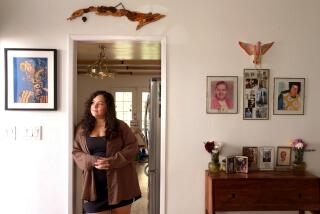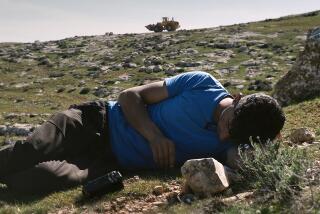At 50, the AFI Conservatory keeps its focus on developing great filmmakers
- Share via
It was an impressive first class, to say the least.
When the AFI Center for Advanced Film Studies — now known as the AFI Conservatory — opened 50 years ago, the students included cinematographer Caleb Deschanel and filmmakers Terrence Malick and Paul Schrader.
“Now, there are hundreds of film schools, but at that time AFI was basically the fourth film school,” said six-time Oscar nominee Deschanel. “There was UCLA, USC and NYU. They were the only film schools that really had a full curriculum in film.”
AFI, though, was unstructured to say the least. The school was then located at the spacious and lavish Greystone Mansion, a.k.a. the Doheny Mansion, in Beverly Hills. In 1981, it moved to the 8-acre former Immaculate Heart College campus near Griffith Park.
“There were no courses,” Deschanel recalled. “People would come in and sort of give talks, but it wasn’t like at 10 a.m. you have a course in cinematography and then you have editing at 2 in the afternoon. There was none of that.”
The “fellows,” as the students are called, “kind of controlled things. Because we had a projection room, we could look at movies anytime we wanted,” he said. “We would order up a lot of films.”
Eventually they started on projects. “Terry got together a movie, which I ended up shooting,” said Deschanel.
David Lynch, who accepted a scholarship at AFI in 1970, made his 1977 masterpiece “Eraserhead” while a fellow; he shot it at the stables on the mansion’s grounds.
The early fellows also had internships with established professionals. Though they wanted Deschanel to intern with a veteran cinematographer, he selected newcomer Gordon Willis, who went on to be the DP on countless films including the three “Godfather” movies.
The AFI Conservatory is celebrating its 50th anniversary Thursday evening at Greystone Mansion with a cocktail reception and short program. Numerous alumni and faculty are scheduled to attend, including filmmaker George Stevens Jr., who helped found the AFI and was its first director and CEO. (The AFI started in 1967; the AFI Conservatory was created two years later as a place where young filmmakers could learn their craft from people in the industry.)
“The AFI and the conservatory was really inspired by President Kennedy — his belief in the importance of the arts,” said Stevens. “Then it flowered under [President Lyndon] Johnson’s Great Society. When it began 50 years ago we wanted to create a tutorial tradition, having filmmakers come and speak with the fellows. We have done that. That’s been one of the great strengths.
“Over the years, almost all of the great filmmakers have come and met us and spoken to and mentored the fellows. We saw it as a bridge between the learning of filmmaking and the profession.”
Other famed alumni include directors Carl Franklin (“Devil in a Blue Dress”), Ed Zwick (“thirtysomething,” “Glory”), Marshall Herskovitz (“thirtysomething,” “Nashville”), Patty Jenkins (“Wonder Woman”) and cinematographer Rachel Morrison, who became the first woman to be nominated for an Oscar with 2017’s “Mudbound.”
Just in the past five years, alumni have received 11 Oscar nominations and two wins, as well as 81 Emmy nominations and 11 wins. Lynch is also an honorary Oscar recipient this year.
There are currently 264 fellows at the conservatory, and this year’s graduating class was 45% female and 55% male, with 38% international students. The 2020 graduating class is 55% female.
Oscar-winning writer-director-producer James L. Brooks (“Terms of Endearment”) is currently the artistic director at AFI. Susan Ruskin was named this past June as the new — and first female — dean of the conservatory. She spent the last six years as dean of filmmaking at the University of North Carolina School of the Arts.
With the 50th anniversary, said AFI president and CEO Bob Gazzale, “What we are really doing is celebrating the audacious ambition of a federally funded program for the arts. Let’s not forget that, for it is. It’s an experiment that proved true.”
The best film schools are intense experiences, and AFI’s two-year program is no exception. “We had a young woman who spoke at our graduation,” Gazzale recalled. “She had a master’s in education at Harvard and decided she wanted to be an editor. She called the AFI program ‘grad school on steroids,’ where it’s two years where you are going to commit your life to this.”
Zwick, who met his producing partner Herskovitz and Steven Rosenblum, who has edited his features, at AFI 45 years ago, pointed out that the conservatory was not an accredited program when he attended. “I think we all got our master’s about five or six years later. Getting a master’s was not by any means the goal.”
Zwick remembered that by his second day at AFI he was already working on a film project. “You end up working with someone from the cinematography program, the design program and someone from the editing program. It’s kind of a boot camp that’s modeled on what people do when they first go to the military or when they have to go into physical training. If you can get through this, you know, the business itself will seem a little less intimidating. “
Cinematographer Morrison graduated from AFI in 2006.
“I love to shoot,” she said. “The program is the Shangri-La of cinematographers.”
And she agreed with Zwick that it is very much a boot camp. “You have nothing else going on in your life for two years. You live, eat and breathe film. “
Among the highlights of her two years at AFI was cinematographer Robert Elswit getting the students involved in the shooting of “Good Night, and Good Luck.”
“The first year we rotated set visits and then in my second he came back and presented the completed film,” said Morrison. “It was an awesome experience. We got to see the production side of film and then the postproduction side.”
Zwick said that many of the graduates return to campus “whenever we have a movie we can bring. It’s a way of trying to foster that community that we need to believe in, or we want to have sustained and keep that influence going. We feel we were given something when we were there very early on and we are determined to try and maintain its spirit at least as best we can.”
More to Read
Only good movies
Get the Indie Focus newsletter, Mark Olsen's weekly guide to the world of cinema.
You may occasionally receive promotional content from the Los Angeles Times.










